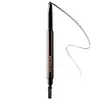What's inside
What's inside
 Key Ingredients
Key Ingredients

 Benefits
Benefits

 Concerns
Concerns

 Ingredients Side-by-side
Ingredients Side-by-side

Hydrogenated Vegetable Oil
EmollientPolyglyceryl-2 Triisostearate
EmulsifyingHydrogenated Coco-Glycerides
EmollientMica
Cosmetic ColorantSynthetic Wax
AbrasiveCopernicia Cerifera Wax
Zinc Stearate
Cosmetic ColorantTriethoxycaprylylsilane
Caprylic/Capric Glycerides
EmollientPolybutene
Tocopheryl Acetate
AntioxidantSorbitan Tristearate
EmulsifyingAluminum Hydroxide
EmollientHelianthus Annuus Seed Oil
EmollientPolyglyceryl-3 Diisostearate
EmulsifyingCarthamus Tinctorius Flower Extract
Skin ConditioningHibiscus Sabdariffa Flower Extract
Skin ConditioningIron Oxides
CI 77492
Cosmetic ColorantCI 77499
Cosmetic ColorantCI 77891
Cosmetic ColorantHydrogenated Vegetable Oil, Polyglyceryl-2 Triisostearate, Hydrogenated Coco-Glycerides, Mica, Synthetic Wax, Copernicia Cerifera Wax, Zinc Stearate, Triethoxycaprylylsilane, Caprylic/Capric Glycerides, Polybutene, Tocopheryl Acetate, Sorbitan Tristearate, Aluminum Hydroxide, Helianthus Annuus Seed Oil, Polyglyceryl-3 Diisostearate, Carthamus Tinctorius Flower Extract, Hibiscus Sabdariffa Flower Extract, Iron Oxides, CI 77492, CI 77499, CI 77891
Hydrogenated Soybean Oil
EmollientHydrogenated Coco-Glycerides
EmollientMica
Cosmetic ColorantHydrogenated Vegetable Oil
EmollientMicrocrystalline Wax
Emulsion StabilisingCaprylic/Capric/Myristic/Stearic Triglyceride
EmollientSynthetic Wax
AbrasiveAcrylates/Stearyl Acrylate/Dimethicone Methacrylate Copolymer
Ethylene/Propylene Copolymer
AbrasiveCaprylyl Glycol
EmollientTocopheryl Acetate
AntioxidantEthylhexylglycerin
Skin ConditioningBHT
AntioxidantTocopherol
AntioxidantCI 77891
Cosmetic ColorantIron Oxides
Hydrogenated Soybean Oil, Hydrogenated Coco-Glycerides, Mica, Hydrogenated Vegetable Oil, Microcrystalline Wax, Caprylic/Capric/Myristic/Stearic Triglyceride, Synthetic Wax, Acrylates/Stearyl Acrylate/Dimethicone Methacrylate Copolymer, Ethylene/Propylene Copolymer, Caprylyl Glycol, Tocopheryl Acetate, Ethylhexylglycerin, BHT, Tocopherol, CI 77891, Iron Oxides
Ingredients Explained
These ingredients are found in both products.
Ingredients higher up in an ingredient list are typically present in a larger amount.
Ci 77891 is a white pigment from Titanium dioxide. It is naturally found in minerals such as rutile and ilmenite.
It's main function is to add a white color to cosmetics. It can also be mixed with other colors to create different shades.
Ci 77891 is commonly found in sunscreens due to its ability to block UV rays.
Learn more about CI 77891Hydrogenated Coco-Glycerides isn't fungal acne safe.
Hydrogenated Vegetable Oil is created by adding hydrogen to vegetable oil in order to give it more stability. This process also raises the melting point of vegetable oil. In cosmetics, it is an emollient.
Emollients help soothe and soften the skin. They do this by creating a protective film on your skin. This barrier helps trap moisture and keeps your skin hydrated. Emollients may be effective at treating dry or itchy skin.
The term "Hydrogenated Vegetable Oil" is an umbrella term and can refer to a variety of vegetable oils and blends of: sunflower oil, soybean oil, olive oil, coconut oil, palm oil, and more.
Due to the differences in vegetables, the benefits may vary.
Learn more about Hydrogenated Vegetable OilMica is a naturally occurring mineral used to add shimmer and color in cosmetics. It can also help improve the texture of a product or give it an opaque, white/silver color.
Serecite is the name for very fine but ragged grains of mica.
This ingredient is often coated with metal oxides like titanium dioxide. Trace amounts of heavy metals may be found in mica, but these metals are not harmful in our personal products.
Mica has been used since prehistoric times throughout the world. Ancient Egyptian, Indian, Greek, Roman, Aztec, and Chinese civilizations have used mica.
Learn more about MicaSynthetic Wax is created from fossil fuels such as natural gas. It is used to enhance texture, adjust pH, and as an occlusive.
It may also be used as an abrasive ingredient to exfoliate the skin.
Synthetic Wax may not be fungal acne safe.
Learn more about Synthetic WaxTocopheryl Acetate is AKA Vitamin E. It is an antioxidant and protects your skin from free radicals. Free radicals damage the skin by breaking down collagen.
One study found using Tocopheryl Acetate with Vitamin C decreased the number of sunburned cells.
Tocopheryl Acetate is commonly found in both skincare and dietary supplements.
Learn more about Tocopheryl AcetateThis ingredient is a combination of red, black, and yellow iron oxide pigments. This combination of colors is usually found in foundation, because it results in a "skin" color.